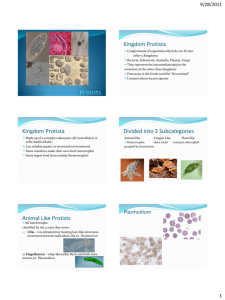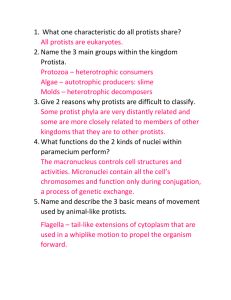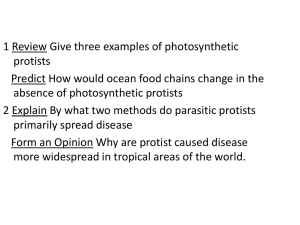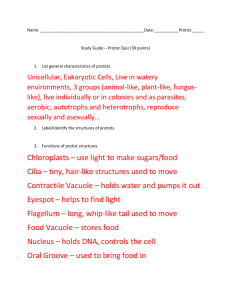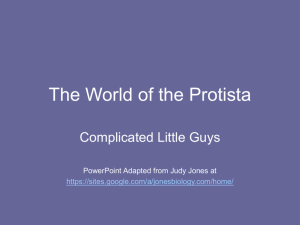Study Guide
advertisement
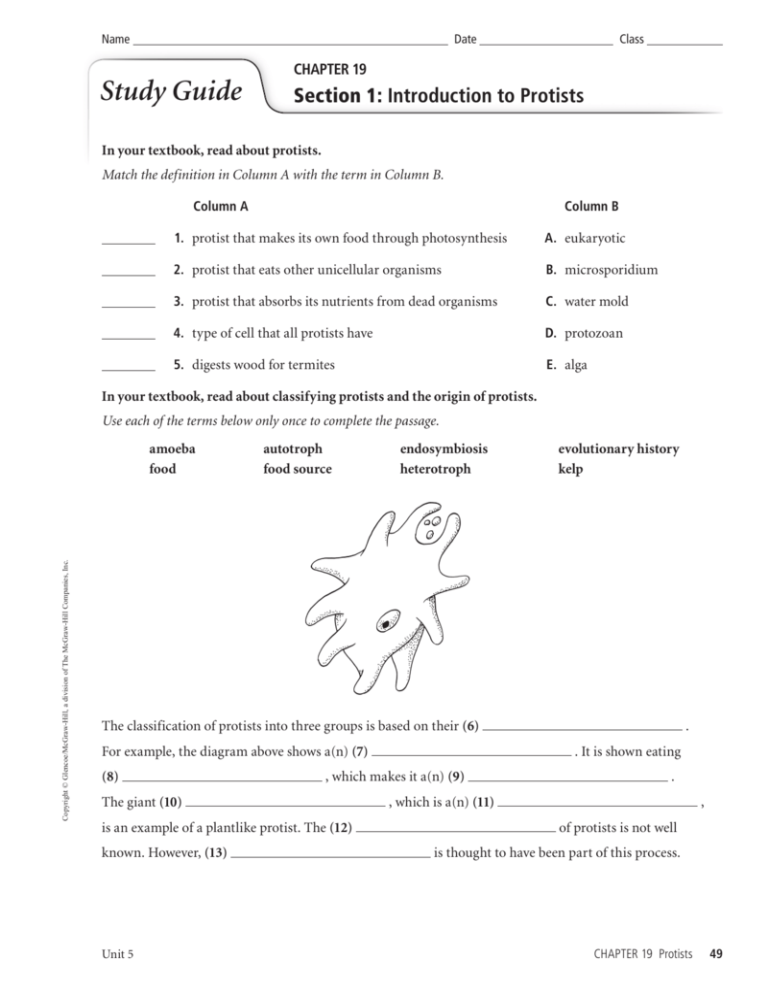
Name Date Class CHAPTER 19 Study Guide Section 1: Introduction to Protists In your textbook, read about protists. Match the definition in Column A with the term in Column B. Column A Column B 1. protist that makes its own food through photosynthesis A. eukaryotic 2. protist that eats other unicellular organisms B. microsporidium 3. protist that absorbs its nutrients from dead organisms C. water mold 4. type of cell that all protists have D. protozoan 5. digests wood for termites E. alga In your textbook, read about classifying protists and the origin of protists. Use each of the terms below only once to complete the passage. Copyright © Glencoe/McGraw-Hill, a division of The McGraw-Hill Companies, Inc. amoeba food autotroph food source endosymbiosis heterotroph evolutionary history kelp The classification of protists into three groups is based on their (6) For example, the diagram above shows a(n) (7) (8) is an example of a plantlike protist. The (12) known. However, (13) Unit 5 . It is shown eating , which makes it a(n) (9) The giant (10) . . , which is a(n) (11) , of protists is not well is thought to have been part of this process. CHAPTER 19 Protists 49 Name Date Class CHAPTER 19 Study Guide Section 2: Protozoans—Animal-like Protists In your textbook, read about paramecia. Label the diagram of the paramecium. Use these choices: cilia contractile vacuole macronucleus micronucleus oral groove In your textbook, read about Ciliophora, Sarcodina, Apicomplexa, and Zoomastigina. Complete the table by checking the correct column(s) for each description. Description Ciliophora Sarcodina Apicomplexa Zoomastigina 6. Reproduce through spores Copyright © Glencoe/McGraw-Hill, a division of The McGraw-Hill Companies, Inc. 7. Use flagella for movement 8. Have numerous short, hairlike projections 9. Use pseudopods for feeding and locomotion Respond to each statement. 10. Name two phyla of protists that have members that cause diseases in humans. 11. Describe what Chagas’ disease is and what causes it. 12. Explain how African sleeping sickness is transmitted to humans. 50 Protists CHAPTER 19 Unit 5 Name Date Class CHAPTER 19 Study Guide Section 3: Algae—Plantlike Protists In your textbook, read about the characteristics, diversity, and life cycle of algae. If the statement is true, write true. If the statement is false, replace the italicized term or phrase to make it true. 1. The three criteria used to classify algae are the types of chlorophyll and secondary pigments, the method of chlorophyll storage, and the composition of the cell wall. 2. All algae are considered plantlike because they contain photosynthetic pigments. 3. Algal blooms occur when euglenoids reproduce in great numbers due to plentiful food and favorable environmental conditions. 4. Bioluminescent dinoflagellates emit light and are usually found in salt water. 5. Algae that have characteristics of both plants and animals are chrysophytes. Copyright © Glencoe/McGraw-Hill, a division of The McGraw-Hill Companies, Inc. 6. The secondary pigment fucoxanthin accounts for the color of red algae. 7. Algae are high in protein and contain minerals, trace elements, and vitamins. 8. Many algae have a life cycle called alternation of generations. In your textbook, read about the life cycle of algae. Label the diagram. Use these choices: gametes gametophytes spores sporophyte 9. 10. 11. 12. Unit 5 CHAPTER 19 Protists 51 Name Date Class CHAPTER 19 Study Guide Section 4: Funguslike Protists In your textbook, read about funguslike protists. Write the term or phrase that best completes each statement. Use these choices: acrasin Oomycota chitin Phytophthora infestans Myxomycota plasmodium 1. The cell walls of funguslike protists do not contain like the cell walls of true fungi. 2. Some slime molds form a(n) 3. A chemical called , which is a moving mass of cytoplasm. signals slime mold amoeboid cells to congregate and form a single sluglike colony. 4. Acellular slime molds belong to the phylum . 5. Water molds and downy mildew in the phylum are often found in water or damp places. 6. The downy mildew devastated the potato crop in Ireland in the nineteenth century, causing many people to starve. In your textbook, read about slime molds. Identify the following life cycles as cycles for acellular slime molds or cellular slime molds. Copyright © Glencoe/McGraw-Hill, a division of The McGraw-Hill Companies, Inc. Haploid amoeba-like cells → sexual reproduction → diploid zygote → giant cell → meiosis, then multiple mitosis → cell rupture → haploid amoeba-like cells 7. Spores → haploid flagellated and amoeba-like cells → fertilization → diploid plasmodium → meiosis → spores 8. The diagram shows a multicellular amoeba-like mass. For each statement below, write true or false. 9. The diagram shows a plasmodium. -ULTICELLULAR AMOEBALIKEMASS 10. The diagram shows a cellular slime mold. 52 Protists CHAPTER 19 Unit 5



